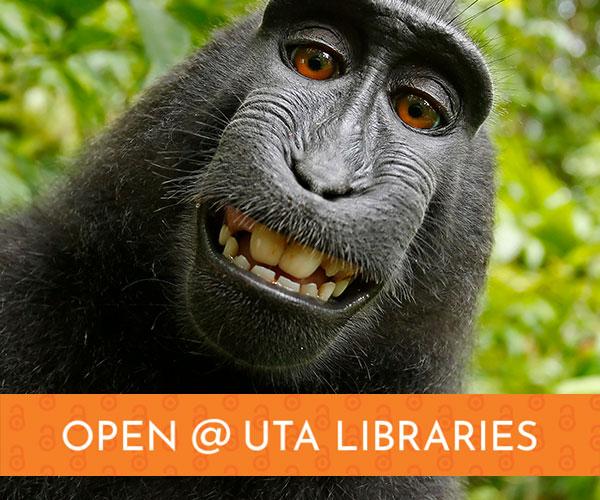
Using Generative AI in OER Creation—What We Know Now
It has been impossible to avoid the topic of artificial intelligence (AI) in higher education so far in 2024, and we are only at the beginning of what promises to be a long and complex conversation touching on ethics, student success, privacy, copyright, and much more. While it is exciting to explore the early stages of a new technology that will have a lasting impact on the way we teach and learn, it can be challenging to keep track of what we know for sure and what is still uncertain. On the broader topic of AI, the Artificial Intelligence at UTA page contains news, events, and local guidance on using AI in instruction and research. This blog post will give a summary of some of the current rules, guidelines, and best practices for using AI in open educational resource (OER) creation, as well as some thoughts on how this topic might evolve in the future.
Copyright
Ethical reuse of copyrighted material is at the heart of OER work. OER are defined by their open licenses, which outline permissions granted by the copyright holder to the OER user. Copyright is automatically granted to a creator when an original work of authorship is fixed in a tangible form and lasts (in the United States) for the lifetime of the creator plus 75 years, after which the work enters the public domain. Open licenses do not remove or replace copyright but rather allow the copyright holder to reserve some of their authorial rights while providing free (i.e., no cost) access and additional usage permissions to others. While permissions vary depending on the license selected, every Creative Commons license contains the BY element, requiring users to attribute the original work to its author whenever they use, share, or modify an open resource.
With all of that in mind, copyright for AI-generated material is one of the most important points we must consider when using AI in OER creation. Unfortunately, there is still a lot of uncertainty and disagreement about what is or is not covered by copyright. Legal cases to determine copyrightability of AI-generated content thus far have focused heavily on the term “authorship.” According to legal precedent as of the writing of this blog post, authorship applies only to human authors—remember the famous case of the monkey selfie? While a human is involved in the initiation stage of the AI process through writing and refining prompts, courts have ruled that the AI-generated product is not human-authored and therefore not copyrightable. As a result, any work generated by AI would automatically be in the public domain and not subject to copyright laws.

If AI-generated resources, such as images and graphics, are in the public domain, that’s great news for OER creation, right? Not so fast—there are still a lot of tangled copyright issues being worked through in legal cases that may tighten up guidelines in the future. While we currently can’t claim copyright on the output of the AI process, that is not the case for most of the content used to train the AI models. Lawsuits against tech companies for misusing copyrighted material in training AI are pending in several industries, and Rep. Adam Schiff (CA) has proposed a bill that would require companies to be more transparent about using copyrighted material in this way. In the future, content produced by an AI model trained on copyrighted material might be considered a derivative of an original work or a work of joint authorship.
During this uncertain period, OER authors planning to use AI-generated content can follow some record-keeping and documentation practices that may prove useful if legislation or legal guidelines change in the future. Maintaining detailed documentation is a best practice for reusing openly licensed material, so we can apply this same procedure to record-keeping for AI-generated content. We recommend keeping track of what content is being reused, where in the OER it is being used, and what license it has been given. A useful example document has been shared as part of the Open Education Network’s Pub101 curriculum. For AI content, it would also be helpful to note which AI tool was used to create the content and the submitted prompt.
Future Opportunities for Using AI in OER
While the copyright issues seem daunting, OER provides some unique opportunities for using AI. At the UT System conference on Innovating Teaching and Learning in the Era of Generative AI earlier this year, Posie Aagaard of UTSA and Dr. Art Brownlow of UTRGV proposed using AI to help generate ancillary materials, such as question banks for open-source homework platforms. While dedicated faculty, including those here at UTA, have contributed to the increasing number of comprehensive and high-quality OER available, creation of quality ancillary materials has been slower. Setting up open-source homework platforms, such as WeBWorK, requires an investment of time and effort to generate enough content to make the platform useful. This proposed AI-assisted approach should be able to generate a large amount of ancillary material quickly and potentially skirts the copyright issues discussed above because the AI would be trained on the corresponding OER textbook, which would, of course, be openly licensed for reuse.
Even without considering AI assistance, open-source homework platforms may prove relevant over the next year as an even more affordable alternative to inclusive-access models, which are being closely examined at the federal level. Proposals from the Department of Education include making inclusive access programs opt-in rather than opt-out, as they currently are.
Stay informed on AI
I look forward to seeing how this topic develops over the next academic year and discussing future opportunities and challenges. To stay up to date on developments in this area, keep an eye on the Artificial Intelligence at UTA page. We have also added a new OER and AI channel to our Open Educational Resources Team to collect relevant internal and external workshops and webinars, best practices, and other helpful resources. The OER Teams channel is open to all UTA faculty, staff, and students. If you are interested in talking more about using AI in OER or about OER in general, please email oer@uta.edu.
The cover image for this blog post is "Monkey Selfie with Banner" by Jessica McClean, licensed CC BY 4.0. The original image is in the public domain and was modified to add the orange "Open @ UTA Libraries" banner.

Add new comment